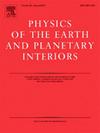(Mg,Fe)O在高达125 GPa时的晶体优选取向,由旋转金刚石砧细胞的扭转变形实验推断
IF 1.9
3区 地球科学
Q2 GEOCHEMISTRY & GEOPHYSICS
引用次数: 0
摘要
为了研究(Mg,Fe)O的织构发展,我们利用旋转金刚石砧细胞结合同步加速器x射线,在高达125 GPa的压力和高达900 K的温度下,对不同铁含量的(Mg,Fe)O进行了扭转变形实验。结果表明,当Fe含量发生变化或发生自旋转变时,织构的发展趋势与MgO相同。然而,我们发现垂直于(Mg,Fe)O压缩方向的晶面在较低的压力和温度条件下可以从{110}转变为{100},这是由于Fe掺入的影响。此外,(Mg,Fe)O的织构随铁含量和应变的变化而变化。在高铁含量和大应变的区域,如D″层,考虑铁含量和应变的影响,可能有必要基于织构评价(Mg,Fe)O的地震各向异性。本文章由计算机程序翻译,如有差异,请以英文原文为准。

Crystallographic preferred orientation of (Mg,Fe)O up to 125 GPa inferred from torsional deformation experiments using a rotational diamond anvil cell
To investigate the texture development of (Mg,Fe)O, we conducted torsional deformation experiments on (Mg,Fe)O with varying Fe contents under pressures up to 125 GPa and temperatures up to 900 K using a rotational diamond anvil cell combined with synchrotron X-rays. The results indicate that the texture development follows the same trend as that observed in MgO, even when the Fe content varies or undergoes a spin transition. However, we found that the crystal plane perpendicular to the compression direction of (Mg,Fe)O could transition from {110} to {100} at lower pressure and temperature conditions than in MgO, attributable to the effect of Fe incorporation. Additionally, the texture of (Mg,Fe)O may vary with the combination of Fe content and strain. In regions with high Fe content and large strains, such as the D″ layer, it may be necessary to evaluate the seismic anisotropy of (Mg,Fe)O based on the texture considering the effects of Fe content and strain.
求助全文
通过发布文献求助,成功后即可免费获取论文全文。
去求助
来源期刊

Physics of the Earth and Planetary Interiors
地学天文-地球化学与地球物理
CiteScore
5.00
自引率
4.30%
发文量
78
审稿时长
18.5 weeks
期刊介绍:
Launched in 1968 to fill the need for an international journal in the field of planetary physics, geodesy and geophysics, Physics of the Earth and Planetary Interiors has now grown to become important reading matter for all geophysicists. It is the only journal to be entirely devoted to the physical and chemical processes of planetary interiors.
Original research papers, review articles, short communications and book reviews are all published on a regular basis; and from time to time special issues of the journal are devoted to the publication of the proceedings of symposia and congresses which the editors feel will be of particular interest to the reader.
 求助内容:
求助内容: 应助结果提醒方式:
应助结果提醒方式:


